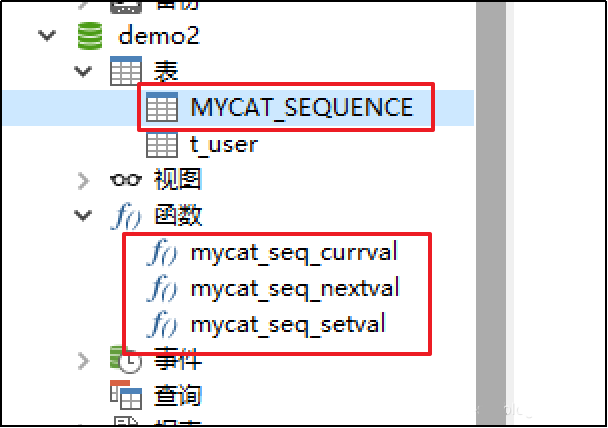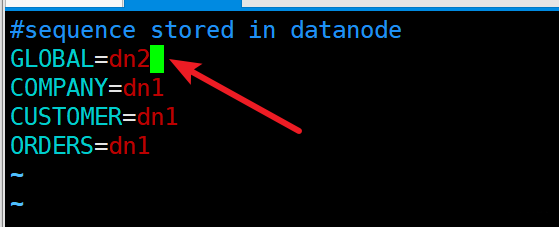Global primary key auto increment
I. self increasing method of local files
1. Modify fragmentation strategy

2. Modify the server.xml file
sequnceHandlerType in server.xml file is used to configure the primary key generation type
| sequnceHandlerType value | Explain |
|---|---|
| 0 | Local file auto increment mode |
| 1 | Database auto increment mode |
| 2 | Local time stamp auto increment method |
So we need to change the value of sequnceHandlerType to 0 first.

3. Introduction to sequence_conf.properties
#Wed Oct 16 07:40:44 CST 2019 COMPANY.MAXID=2000 GLOBAL.MAXID=20000 COMPANY.HISIDS= CUSTOMER.MAXID=2000 HOTNEWS.CURID=1000 ORDER.MINID=1001 CUSTOMER.HISIDS= HOTNEWS.MINID=1001 GLOBAL.CURID=10002 ORDER.MAXID=2000 COMPANY.CURID=1000 CUSTOMER.CURID=1000 COMPANY.MINID=1001 GLOBAL.MINID=10001 HOTNEWS.MAXID=2000 CUSTOMER.MINID=1001 GLOBAL.HISIDS= HOTNEWS.HISIDS= ORDER.HISIDS= ORDER.CURID=1000
The main thing is that global. Maximum = 20000 global. Curid = 10002 global. Minid = 10001 can be set by yourself.
4. Test implementation
Replace the primary key field with next value for mycatseq "global in the insert statement
insert into t_user(id,name,age)values(next value for MYCATSEQ_GLOBAL,'HG-93',23)
II. Local time stamp auto increment method
using timestamps, we do not need to assign policies or choose other fragmentation policies.


1. Modify the server.xml file
change sequnceHandlerType in the server.xml file to 2

2. Restart mycat

3. Insert data test
insert into t_user(id,name,age)values(next value for MYCATSEQ_GLOBAL,'HG-93',23)
Timestamp too long change id to varchar type.

Build successful~
III. database auto increment mode
1. Create sequence table and related functions
The third way is to create an auto increasing table structure in a database managed by Mycat to maintain related data. The related scripts are officially provided as follows:
DROP TABLE IF EXISTS MYCAT_SEQUENCE; CREATE TABLE MYCAT_SEQUENCE ( NAME VARCHAR (50) NOT NULL, current_value INT NOT NULL, increment INT NOT NULL DEFAULT 100, PRIMARY KEY (NAME) ) ENGINE = INNODB ; INSERT INTO MYCAT_SEQUENCE(NAME,current_value,increment) VALUES ('GLOBAL', 100000, 100); DROP FUNCTION IF EXISTS `mycat_seq_currval`; DELIMITER ;; CREATE FUNCTION `mycat_seq_currval`(seq_name VARCHAR(50)) RETURNS VARCHAR(64) CHARSET utf8 DETERMINISTIC BEGIN DECLARE retval VARCHAR(64); SET retval="-999999999,null"; SELECT CONCAT(CAST(current_value AS CHAR),",",CAST(increment AS CHAR) ) INTO retval FROM MYCAT_SEQUENCE WHERE NAME = seq_name; RETURN retval ; END ;; DELIMITER ; DROP FUNCTION IF EXISTS `mycat_seq_nextval`; DELIMITER ;; CREATE FUNCTION `mycat_seq_nextval`(seq_name VARCHAR(50)) RETURNS VARCHAR(64) CHARSET utf8 DETERMINISTIC BEGIN UPDATE MYCAT_SEQUENCE SET current_value = current_value + increment WHERE NAME = seq_name; RETURN mycat_seq_currval(seq_name); END ;; DELIMITER ; DROP FUNCTION IF EXISTS `mycat_seq_setval`; DELIMITER ;; CREATE FUNCTION `mycat_seq_setval`(seq_name VARCHAR(50), VALUE INTEGER) RETURNS VARCHAR(64) CHARSET utf8 DETERMINISTIC BEGIN UPDATE MYCAT_SEQUENCE SET current_value = VALUE WHERE NAME = seq_name; RETURN mycat_seq_currval(seq_name); END ;; DELIMITER ;
We execute these scripts on demo2

2. Modify server.xml

3. Modify the sequence DB conf.properties file
because the logical library corresponding to demo2 is dn2, we need to modify here

4. test
restart service and insert data test

insert into t_user(id,name,age)values(next value for MYCATSEQ_GLOBAL,'hg-93',23)
The generation of primary key is successful. In addition to these three ways, you can also maintain the self increasing primary key through 'zookeeper', which can be implemented by yourself.